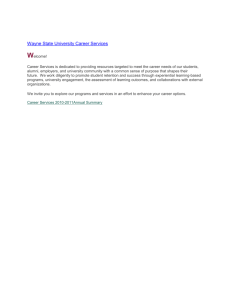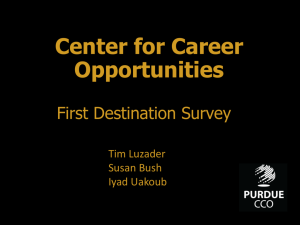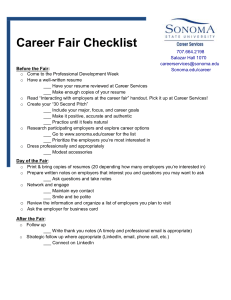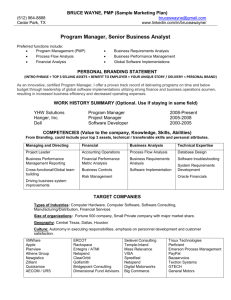EDC Reentry Spring Workshop'12
advertisement
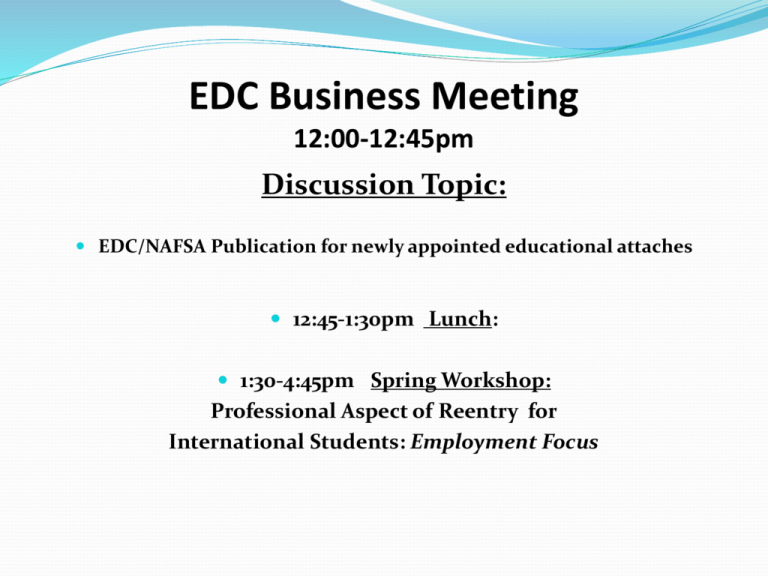
EDC Business Meeting 12:00-12:45pm Discussion Topic: EDC/NAFSA Publication for newly appointed educational attaches 12:45-1:30pm Lunch: 1:30-4:45pm Spring Workshop: Professional Aspect of Reentry for International Students: Employment Focus Professional Aspect of Reentry for International Students 1:30-1:45 1:45-2:00 2:00-2:25 2:25-2:45 2:45-3:00 Embassy Welcome Framing the Reentry Issue (Senem Bakar, EDC Chair) Overview of the Student Experiences (Dr. Fanta Aw, AU) What Employers Value (Martin Tillman, Global Career Compass) Discussion 3:00-3:15 Coffee Break & Networking 3:15-4:30 PANEL: Best Practices Moderated by Dr. Deirdre Evans-Pritchard Embassy (Aysha Murad, Embassy of Bahrain) Institution (David Fletcher, AU Career Services) AMIDEAST (Deirdre Evans-Pritchard) Alumni Networking (Department of State) 4:30-4:45 Q & A EMBASSY WELCOME H.E. Ambassador Houda Ezra Nonoo Senem Bakar EDC Chair The Internationally Mobile Student May be defined based on: permanent residency, citizenship or prior education. 1. “… are those who study in a foreign country of which they are not a permanent resident” by UNESCO Institute for Statistics. 2. “..are non‐immigrant international students in the U.S. on temporary visas at the postsecondary level” by the Open Doors, IIE. Sources: United Nations Educational, Scientific and Cultural Organization (UNESCO)Institute for Statistics, Open Doors, IIE Global Student Mobility International Students Worldwide Source: Atlas of Student Mobility Top Host Destinations Worldwide For Global Mobility (2009-2010) 2009 2010 Destination Int'l Students Int'l Students % Change U.S. 690,923 723,277 4.7 UK 415,585 455,600 9.6 France 266,448 283,621 6.4 China 238,184 265,090 11.3 Australia 253,717 258,827 2.0 Germany 244,776 252,032 2.9 Canada 161,679 174,760 8.1 Japan 132,720 141,774 6.8 Source: Atlas of Student Mobility What to Cope With may include: Job market with excess supply of workforce Gender Preferences in employment Homes in Crisis Reentry to the Workplace High Expectations Difficulty to communicate what was learned (lack of context) AREAS OF CONCERN for REENTRY: AU Example 80% 70% 60% 50% 40% 30% 20% 10% 0% Employment Cultural Transition General Concern and Uncertainty Social Reintegration Gender Differences and Expectations 74% 43% 43% 26% 24% Fanta Aw Assistant Vice President, American University The Voice of Returnees “I’ve come because of Opportunities. I want to help my country and humanity” “I could see my future very clearly in the United States. I could have Stayed and lived a nice life and retired, but It did not seem to be enough. “ PULL-PUSH FACTORS IMMIGRATION POLICIES IN HOST COUNTRY NATION STATE POLICIES- HUMAN CAPITAL DEVELOPMENT ECONOMIC CONDITIONS- HOME AND HOST PRESENCE OF MULTINATIONAL CORPORATIONS (MNCs) GOVERNMENT OR INDUSTRY INCENTIVES FAMILY VALUES GENDER ROLES QUALITY OF LIFE ISSUES BRAIN CIRCULATION INTERNATIONAL STUDENT AND RE-ENTRY EXPERIENCE EXTERNAL FORCES INTERNATIONAL STUDENT INTERNAL FORCES • Filial obligations/expectations • Perceived/Real value of Overseas degree & education • Demand for Skills • Social/Professional Networks • Business attitude • Work expectations • Economic Conditions • Transition • Professional integration • Persistence • Other • • • • • • Family values- Caring for the aging Identity-mono/bi/multi Social acceptance/rejection Psychosocial adjustments Relevance of professional experience Cost-Benefit of decision Research- Findings Availability of Economic Opportunities Family Ties Access to markets (local and global) Contributions to Home Country Econ Dev Lower Business Cost Government Incentives Quality of Life Speed of Professional Growth and Recognition Source: Kauffman Foundation- Wadhwa, Saxenia and al. Martin Tillman President, Global Career Compass My Blog: http://globalcareercompass.wordpress.com “…With talent as the critical issue facing both local and global organizations, those of us in higher education are forced to look beyond our campuses, because the employability of our graduates is at stake, as well as the capacity of these organizations to grow and create those jobs we hear about.” Gilles Bousquet, Dean, Division of International Studies & Vice Provost for Globalization, University of Wisconsin-Madison, The Growing Demand for Talent, Chronicle of Higher Education, Dec. 20, 2011 Impact of Globalization Globalization of the workplace- coupled with the rise of a more mobile international workforce- has resulted in a new transnational academic narrative supporting the re-alignment of international programs to achieve gains in competencies that add value to student career decision-making and postgraduate job searches. WHAT MATTERS TO EMPLOYERS “…In today’s global economy, where complexity and change are the norm, attracting and retaining culturally competent talent will continue to be a challenge for companies globally. International experience has become a critical asset for all global organizations and will continue to create a competitive advantage – both for individuals and for the companies that hire them” Laurette Bennhold-Samaan, Managing Director, Aperian Global, an intercultural consulting, training, and web tools company (personal correspondence, June 14, 2011) New Rationale for International Experience Global marketplace demands increased adaptability, cross-cultural sensitivity, political awareness ,intellectual flexibility Employers take more active interest in outcomes of education abroad experiences to build sophisticated and informed workforce Employers interested in whether applicant demonstrates that as a result of international experience, they developed skills and sensitivity making them stand out as strongest candidate Research Supports Value of IE to Employers American employers look for graduates with broad range of skills and in-depth [technical] knowledge Employers believe it’s essential graduates have ability to apply learning in real-world settings (Hart Research Associates, 2010) 2011 QS Survey- largest ever conducted on global scale… The Globally Competent Student Comprehends international dimensions of their major field of study Effectively communicates in another language and/or cross-culturally Has diverse and knowledgeable worldview Demonstrates cross-cultural sensitivity & adaptability Continues global learning throughout life [and in career choices] NASULGC International Task Force Report, 2004 What Employers Look For? Domain knowledge (subject expertise) Cognitive, social, and personal skills Prior work experience Cross-cultural experience Rand Corporation/National Association of Colleges and Employers, 1994 (First-ever survey-all subsequent surveys validate findings) 2011 QS Global Survey of Employers Report based on over 10,000 respondents from 116 countries on five continents- largest opinion survey of its type undertaken to date: http://content.qs.com/qs/qs-global-employer-survey2011.pdf KEY FINDING: 60% of employer respondents state they value international study when recruiting talent International Education in U.S. & Employability: What’s the Linkage? Global Hiring & U.S.-Educated Foreign Nationals: Can Colleges and U.S. Businesses Fulfill Implicit Promises from Participation in U.S. Higher Education? COLLEGIATE EMPLOYMENT RESEARCH INSTITUTE RESEARCH NOTE 4 – 2011, Michigan State University http://www.ceri.msu.edu/wp-content/uploads/2010/01/Global-Hiring-U.S.Educated-Foreign-Nationals1.pdf Survey Parameters Survey of 137 organizations or 28% of all responding participants indicated that they had operations outside U.S Average size: 22,761 employees Sectors dominating: Manufacturing (30%) and Professional and Scientific Services (20%) Other sectors (between 3% and 8%): Finance & Insurance, Government, Retail, Education, information Services and Nonprofits All 50 states and District of Columbia represented with these as key leaders: Illinois, New York, Ohio, Texas, California, Wisconsin, Florida, North Carolina, Michigan, Minnesota, and New Jersey What value do U.S.- educated foreign nationals bring to your organization? Understanding U.S. business customs Understanding U.S. culture (social norms, customs) Increase adaptability to work within diverse environments Increasing diversity of thought among decision-makers Gaining insights into international business practices Developing global mindset for future global leadership positions Introducing U.S. workers to foreign culture Influencing business activities in home country upon return References Collegiate Employment Research Institute, Michigan state University, NOTE 4 – 2011, Global Hiring & U.S.-Educated Foreign Nationals: Can Colleges and U.S. Businesses Fulfill Implicit Promises from Participation in U.S. Higher Education? Phil Gardner, Ian Render Peter D. Hart Research Associates, Inc. (January 20, 2010), “Raising the Bar: Employers’ Views on College Learning in the Wake of the Economic Downturn” Peter D. Hart Research Associates, Inc. (December 28, 2006), “How Should Colleges Prepare Students to Succeed in Today’s Global Economy?” QS Global Employer Survey Report 2011: How Employers Value an International Study Experience, Maloney, Sowter, Potts http://www.nafsa.org/partners.sec/global_partnership_program/globa l_workforce_development My Blog: http://globalcareercompass.wordpress.com DISCUSSION COFFEE BREAK & NETWORKING 3:00-3:15pm PANEL on Best Practices Moderated by Dr. Deirdre Evans-Pritchard Embassy (Aysha Murad, Embassy of Bahrain) Institution (David Fletcher, AU Career Services) AMIDEAST (Deirdre Evans-Pritchard) Alumni Networking(Lisa Barton, Office of Alumni Affairs, DoS ) Q&A Lisa Barton Alumni Outreach Coordinator Office of Alumni Affairs, Department of State Alumni of U.S. Exchanges: A Resource for Advancing Foreign Policy Priorities • Forge long-term relationships; • Maximize the return on investment; • Bolster credible voices; • Empower agents of change; • Provide a deeper understanding of local environments. EDC Contact Information Email edc@american.edu Web Sites www. NAFSA.ORG/MIG-EDC www. Edconeducation.wordpress.com
